Empower Safety and Compliance with Expert Arc Flash Study Services
At Elion Technologies and Consulting Pvt. Ltd., we specialize in comprehensive Arc Flash Studies to safeguard your workplace from electrical hazards. Our expert team conducts detailed analyses of your electrical systems to identify potential arc flash risks and ensure compliance with safety regulations. By assessing fault currents, equipment ratings, and protective device coordination, we help minimize the risk of dangerous incidents, protecting your workforce and infrastructure. With our customized solutions, we empower you to enhance operational safety, reduce downtime, and stay compliant with the latest standards. Trust Elion for reliable, expert-driven Arc Flash solutions.
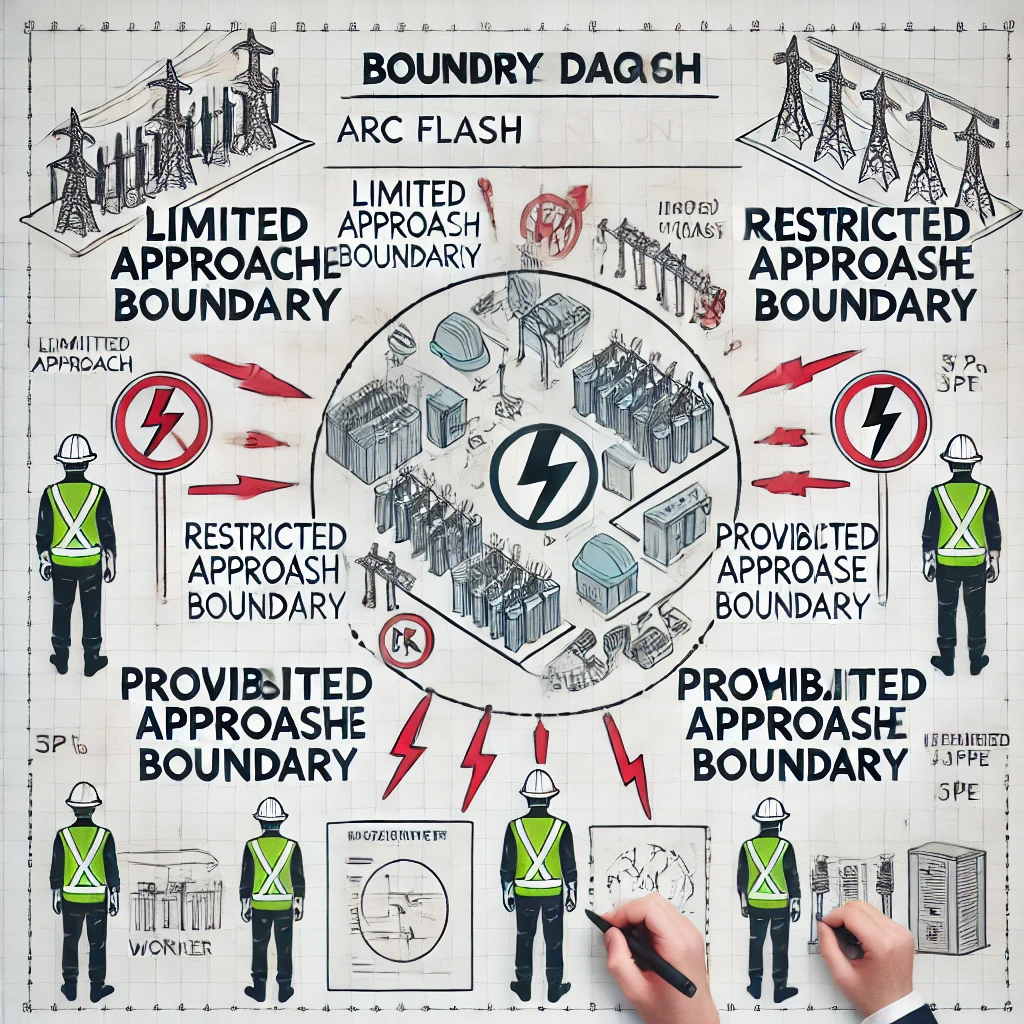
Transform Your Efficiency Now
What is an Arc Flash Study?
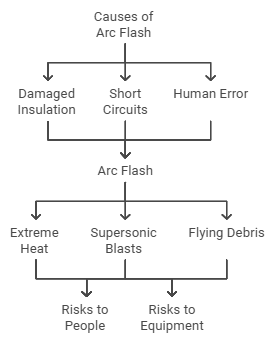
An arc flash is a dangerous electrical explosion caused by an electric current leaving its intended path and traveling through the air. It often occurs due to damaged insulation, short circuits, or human error. The resulting flash can produce extreme heat, supersonic blasts, and flying debris, posing significant risks to people and equipment.
Arc flash is a critical safety concern in electrical systems, representing a dangerous release of energy caused by an electrical fault. This web page explores the concept of arc flash, its causes, effects, and the importance of safety measures in preventing such incidents. Elion, a leader in electrical safety solutions, emphasizes the significance of understanding arc flash to protect personnel and equipment in various industrial settings.
Schedule Your Consultation
Key Benefits
- Enhanced Workplace Safety: Protect your workforce by identifying and mitigating arc flash hazards, ensuring a safer environment for everyone.
- Regulatory Compliance: Stay compliant with industry standards like NFPA 70E and IEEE 1584, avoiding fines and ensuring legal adherence.
- Customized Solutions: Our Arc Flash Studies are tailored to your specific facility and electrical systems, offering personalized safety recommendations.
- Reduced Downtime: Prevent unexpected equipment failures and costly downtime by optimizing your electrical systems and protective devices.
- Expert Insights: Leverage the expertise of our highly trained engineers to receive actionable insights and strategies for minimizing arc flash risks.
- Improved Equipment Reliability: Ensure that your electrical systems operate efficiently and safely with well-coordinated protective devices
- Comprehensive Reporting: Receive detailed reports with clear labeling, safety boundaries, and recommended PPE to help you implement effective safety protocols.
- Cost Efficiency: By preventing accidents and system failures, our Arc Flash Studies can save you money in the long run, protecting both people and assets.
Choose Elion Technologies & Consulting for a thorough, reliable Arc Flash Study that prioritizes safety and efficiency.
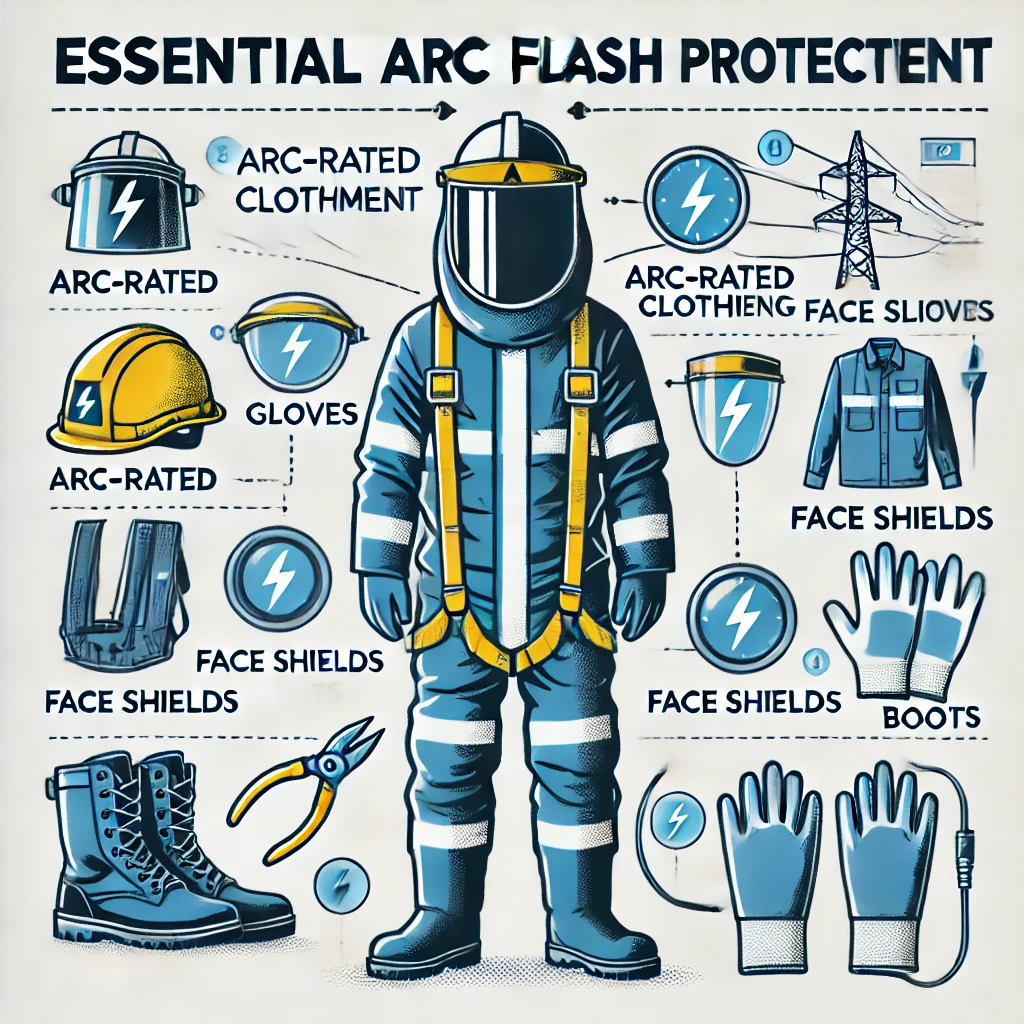
Request a Quote
Key Features
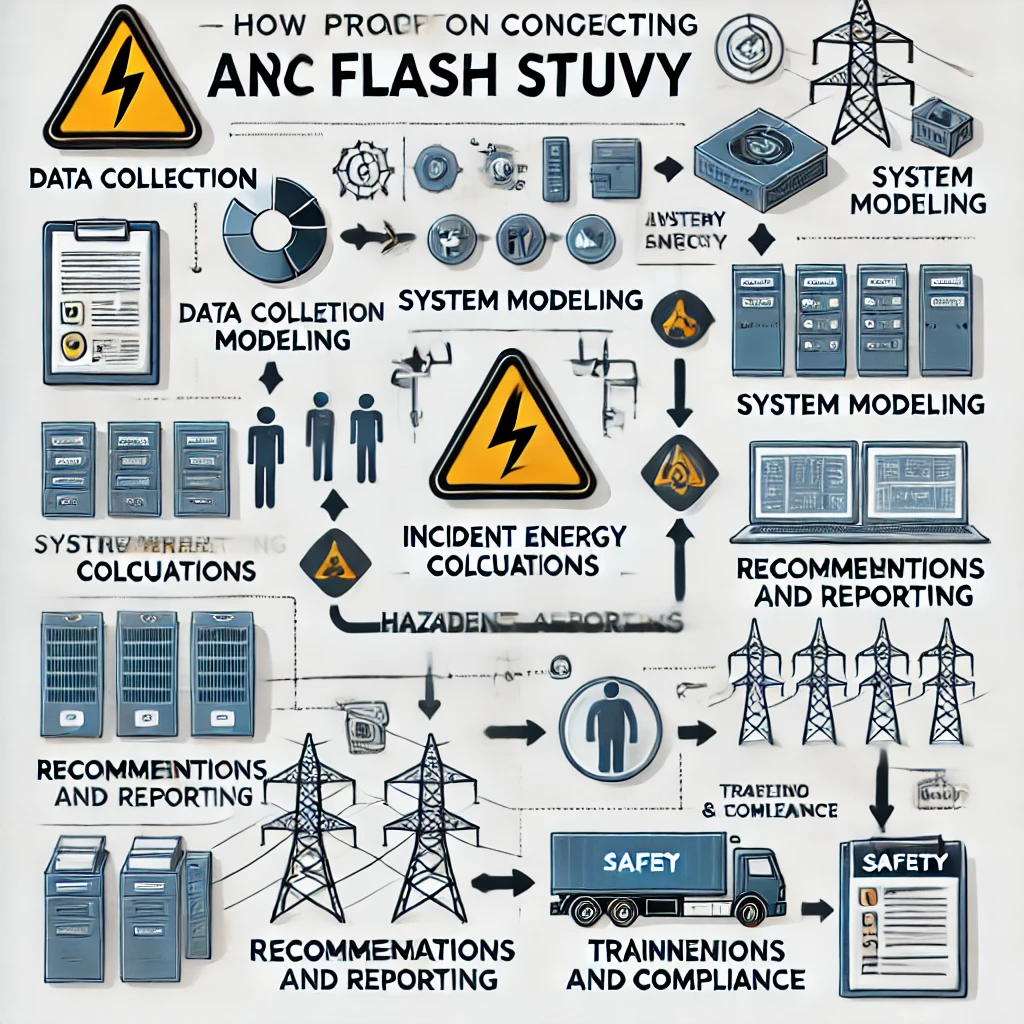
Detailed Hazard Analysis: We conduct a thorough evaluation of your electrical systems to identify potential arc flash hazards and calculate incident energy levels.
Fault Current Calculation: Accurate calculation of fault currents to assess the risk of arc flashes in various parts of your electrical network.
Protective Device Coordination: We review and optimize the coordination of protective devices to ensure that electrical faults are isolated swiftly, minimizing the risk of an arc flash.
Personal Protective Equipment (PPE) Recommendations: Based on our analysis, we provide clear guidance on the appropriate PPE needed for workers in each zone, enhancing overall safety.
Arc Flash Labeling: We deliver easy-to-understand labels for all equipment, clearly marking arc flash boundaries, incident energy, and required PPE levels.
Compliance with Standards: Our studies follow industry standards such as NFPA 70E, IEEE 1584, and OSHA regulations, ensuring your facility remains compliant with the latest safety requirements.
Comprehensive Reporting: Receive a detailed report outlining the study’s findings, recommendations, and steps for risk mitigation, empowering you to implement necessary changes.
Field Data Collection: Our team conducts on-site data collection to ensure accuracy in the analysis, considering real-time conditions of your electrical systems.
Customized Risk Mitigation Strategies: We offer tailored solutions based on your facility’s unique requirements to reduce arc flash risks effectively.
Training and Support: Our experts provide training to your team on arc flash safety protocols, helping them understand the risks and how to implement preventive measures.
With these advanced features, Elion Technologies & Consulting ensures that your Arc Flash Study is comprehensive, precise, and actionable, keeping your facility safe and compliant.
Explore Our Portfolio
Why choose us?
- Expertise You Can Trust: With years of experience in electrical safety and risk analysis, Elion Technologies & Consulting has a team of skilled engineers who are experts in conducting precise Arc Flash Studies. Our deep technical knowledge ensures that we identify hazards accurately and provide effective solutions.
- Comprehensive, Customized Solutions: We understand that no two facilities are the same. Our Arc Flash Study services are tailored to your specific equipment, operations, and safety requirements, ensuring that the solutions we offer are practical and relevant to your needs.
- Commitment to Safety: At Elion, safety is our top priority. Our thorough evaluations and expert recommendations ensure that your workforce and infrastructure are protected from arc flash risks, minimizing the chance of accidents and downtime.
- Up-to-Date with Industry Standards: We adhere to the latest industry regulations, including NFPA 70E, IEEE 1584, and OSHA standards, ensuring your facility remains fully compliant with safety guidelines. This helps you avoid fines and ensures the highest level of protection.
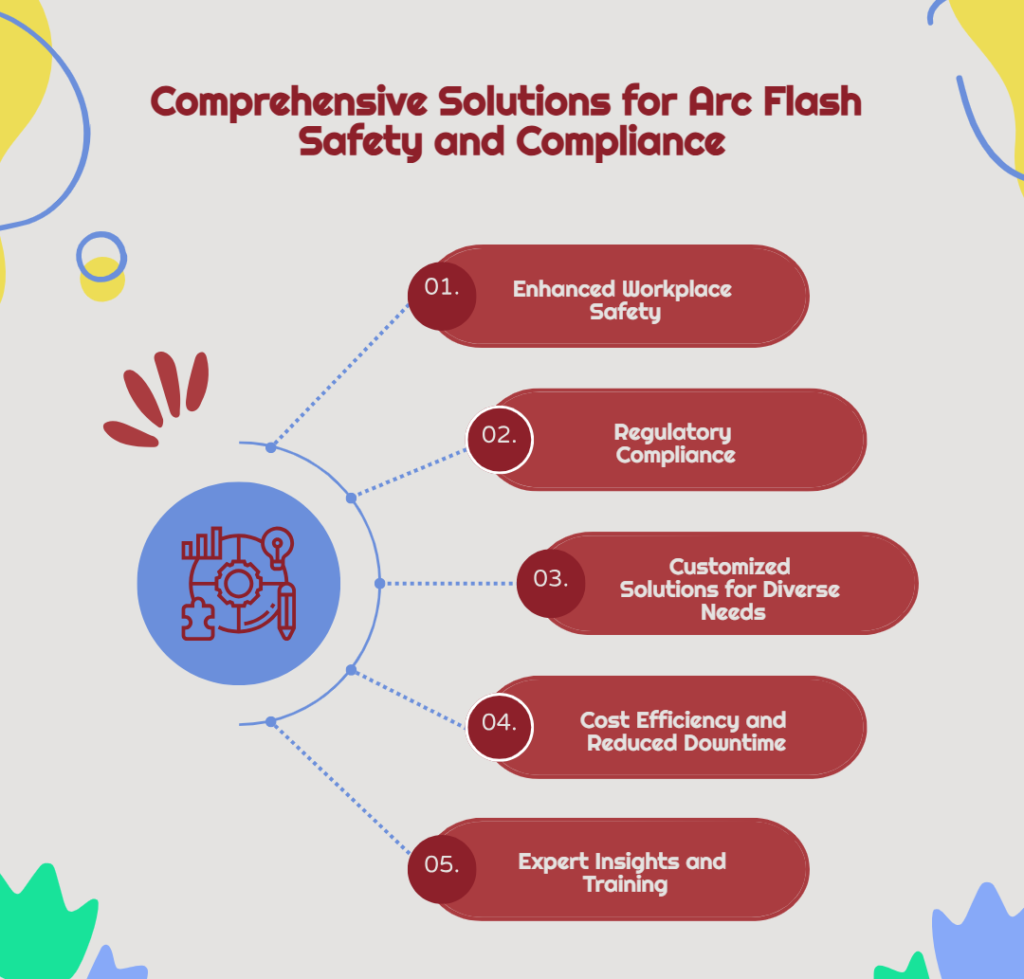
5. Advanced Tools and Techniques: We use cutting-edge software and methodologies to analyze your electrical systems with precision. Our approach enables us to offer detailed and accurate recommendations that improve the safety and efficiency of your operations.
6. Clear and Actionable Reporting: Our Arc Flash Study reports are comprehensive and easy to understand, offering you clear guidance on protective measures, PPE requirements, and safety boundaries. You can quickly implement the recommended changes to enhance workplace safety.
7. End-to-End Support: Beyond the study itself, we offer ongoing support, including employee training, safety workshops, and consultation to help you maintain a safe environment over time.
8. Cost-Effective Solutions: By preventing electrical hazards, reducing downtime, and optimizing system performance, our Arc Flash Study services can save you significant costs in the long run, ensuring a safer, more efficient operation.
Choose Elion Technologies & Consulting Pvt. Ltd. for a reliable, expert-driven Arc Flash Study service that puts safety, compliance, and operational efficiency at the forefront.
Download Our Whitepaper
Industry Experience
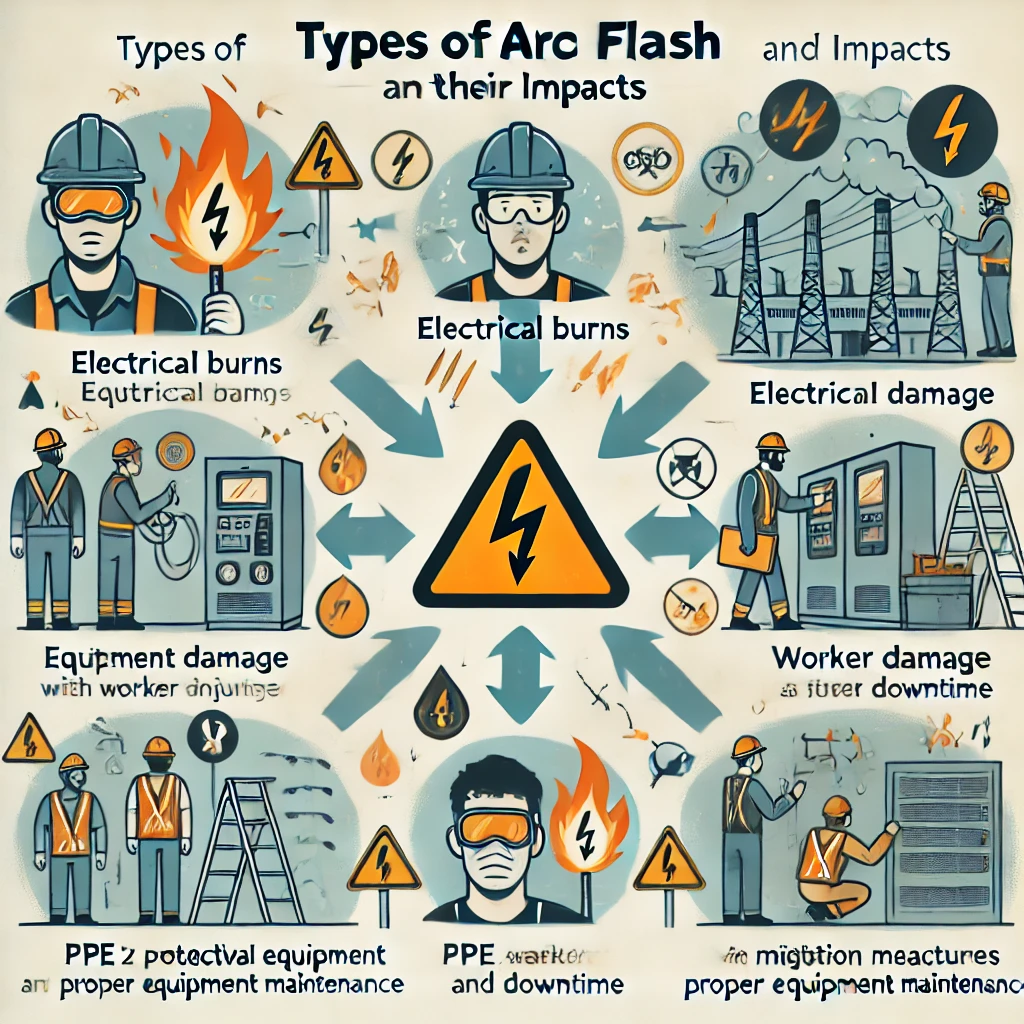
At Elion Technologies & Consulting Pvt. Ltd., we bring extensive experience across a wide range of industries, delivering expert Arc Flash Studies and electrical safety solutions tailored to each sector’s unique needs. Our team has successfully conducted Arc Flash Studies in various industries, ensuring workplace safety and regulatory compliance.
Key Industries We Serve:
- Manufacturing: We’ve worked with major manufacturing plants to assess electrical hazards and ensure safe operations in complex environments with high-energy electrical systems.
- Utilities: Our team has vast experience supporting power generation, transmission, and distribution companies, optimizing protective device coordination to safeguard critical infrastructure.
3. Oil & Gas: With expertise in hazardous environments, we’ve conducted Arc Flash Studies for oil refineries and petrochemical plants, ensuring reliable, risk-free operations.
4. Healthcare: We have helped hospitals and medical facilities protect their sensitive equipment and staff by identifying and mitigating electrical risks in critical care areas.
5. Data Centers: In data centers, where uptime is crucial, we’ve provided Arc Flash solutions to ensure system reliability and prevent costly downtimes.
6. Mining: We’ve conducted Arc Flash Studies in mining operations, ensuring the safety of workers in these high-risk environments where electrical equipment plays a vital role.
7. Commercial Buildings: From large office complexes to high-rise buildings, we’ve provided electrical safety assessments that help maintain secure and compliant operations.
8. Pharmaceuticals: Our experience in pharmaceutical manufacturing facilities helps ensure that strict safety protocols are maintained, minimizing operational disruptions caused by electrical faults.
With years of hands-on experience in diverse industries, Elion Technologies & Consulting has the in-depth knowledge and technical expertise to ensure that your facility is protected against arc flash hazards. We are committed to delivering reliable, efficient, and compliant solutions that enhance safety and operational efficiency across all sectors.
Contact Us for Expert Guidance
FAQs
An Arc Flash Study is a comprehensive assessment of electrical systems to identify potential hazards, calculate incident energy levels, and recommend safety measures to prevent or minimize the impact of Arc Flash incidents.
Arc Flash Studies are crucial for preventing electrical accidents, ensuring personnel safety, complying with regulations, and minimizing downtime caused by electrical incidents.
Arc Flash Studies should be conducted whenever there are changes to the electrical system or every 5 years, as recommended by industry standards.
The process includes data collection, system modeling, incident energy calculations, labeling of equipment, and recommendations for protective measures.
Incident energy is calculated based on factors like fault current, clearing time, and distance from the arc source, using complex engineering formulas.
Arc Flash labels provide critical information about potential hazards, recommended personal protective equipment (PPE), and safe working distances for personnel working on or near electrical equipment.
While some aspects may be done in- house, it’s recommended to involve experienced professionals due to the complexity and specialized tools required.
Yes, various regulations and standards such as NFPA 70E and OSHA require employers to assess and mitigate Arc Flash hazards.
Specialized software simulates electrical faults, predicts potential Arc Flash incidents, and aids in determining appropriate safety measures.
NABL (National Accreditation Board for Testing and Calibration Laboratories) accreditation ensures that instrument calibrations are performed to internationally recognized standards, guaranteeing accuracy.
Mitigation involves implementing engineering controls, work procedures, and personal protective equipment to reduce the risk of Arc Flash incidents.
PPE, such as flame- resistant clothing, gloves, and face shields, is crucial for safeguarding personnel against the thermal and blast effects of an Arc Flash.
Studies identify hazards, recommend safety measures, and empower workers with knowledge to avoid potential incidents, thereby significantly enhancing workplace safety.
Yes, Arc Flash incidents can cause severe damage to electrical equipment, leading to costly downtime and repairs.
Yes, Arc Flash Studies are relevant to all types of electrical systems, including those in renewable energy installations.
The duration varies depending on the complexity of the system, but it usually takes a few weeks to complete.
Elion Technologies boasts a decade of expertise, cutting-edge software utilization, NABL-accredited calibration, and a customized approach that aligns with diverse industries.
While complete elimination is challenging, hazards can be significantly minimized through proper engineering controls and safety measures.
To get started, simply reach out to us through our website, email, or phone, and our dedicated team will guide you through the process.
Stay informed by regularly checking industry standards, attending workshops, and partnering with professionals like Elion Technologies for guidance and training.
An Arc Flash Study is a comprehensive analysis of an electrical system to assess the potential hazards associated with Arc Flash incidents. To conduct a thorough and accurate Arc Flash Study, several key components and data are required. Here’s an overview of what is typically required for an Arc Flash Study:
1. Electrical System Information:
Single-line diagrams: Detailed diagrams of the electrical distribution system, showing equipment, connections, and protective devices.
Equipment data: Comprehensive details about each piece of electrical equipment, including ratings, settings, and locations.
Cable and conductor data: Information about cable lengths, sizes, and types.
2. System Configuration:
Data on system configuration, including power sources, transformers, generators, switchgear, panels, and protective devices.
Details about parallel paths, interlocks, and coordination settings.
3. Load Data:
Accurate load data, including peak demand and load profiles, to determine fault currents and incident energy levels.
4. Fault Current Analysis:
Calculations of available fault currents at various points in the electrical system, considering both bolted and arcing faults.
5. Protective Device Coordination:
Coordination curves and time-current curves for protective devices (circuit breakers, fuses) to ensure proper operation during faults.
6. Time-Current Curves:
Manufacturer data for all protective devices to understand their response time during fault conditions.
7. Equipment Clearing Times:
Information about how quickly protective devices will clear faults, including relay settings and delays.
8. Working Distances:
Determination of safe working distances for personnel from the equipment during fault conditions.
9. Arc Flash Labels:
Clear labeling of equipment with Arc Flash warnings, incident energy levels, required PPE, and other safety information.
10. Software and Analysis Tools:
Specialized software for Arc Flash calculations and simulations to predict incident energy levels and hazard zones.
11. NABL-Accredited Calibration Data:
Calibration certificates for instruments used in the study, ensuring accurate measurements and calculations.
12. Personal Protective Equipment (PPE) Information:
Data on recommended PPE based on incident energy levels and working distances.
13. Documentation and Reports:
Comprehensive study reports detailing findings, analysis results, recommended safety measures, and mitigation strategies.
14. Regulatory Standards:
Familiarity with relevant industry standards and regulations (e.g., NFPA 70E, IEEE 1584) to ensure compliance and accuracy.
Arc flashes are classified into three main categories based on the severity of the incident and the potential hazard they pose to personnel. These categories are determined by the incident energy levels and the distance from the arc source. The three types of arc flash categories are:
1. Category 1 (Less than 1.2 cal/cm²):
Low energy levels that generally pose minimal danger to personnel.
Typically, no PPE is required, but basic flame-resistant clothing may be recommended.
2. Category 2 (1.2 to 12.0 cal/cm²):
Moderate energy levels that can result in significant burns and injuries if proper precautions are not taken.
PPE requirements may include flame resistant clothing, safety glasses, and hearing protection.
3. Category 3 (12.1 to 40.0 cal/cm²):
High energy levels that can cause severe burns, injuries, and potentially fatal consequences.
PPE requirements may include arc-rated clothing, gloves, face shields, and other specialized protective gear.
It’s important to note that the categories are defined by incident energy levels and the associated PPE requirements. Proper assessment, calculation, and labeling of equipment with Arc Flash warnings and incident energy levels help ensure the safety of personnel working in or around electrical equipment. The use of appropriate PPE is crucial to minimize the risks associated with arc flashes and to prevent serious injuries.
In the context of electrical safety, an arc flash is a hazardous electrical event involving the release of a significant amount of energy in the form of intense light, heat, sound, and pressure due to an electric arc. The National Fire Protection Association (NFPA) addresses arc flash hazards and safety guidelines in NFPA 70E, the Standard for Electrical Safety in the Workplace. NFPA 70E provides comprehensive guidelines for establishing a safe work environment and protecting personnel from electrical hazards, including arc flashes. It covers a range of topics, including:
1. Arc Flash Hazard Analysis: NFPA 70E outlines the requirements for conducting an arc flash hazard analysis to assess the potential dangers of arc flashes within a facility’s electrical system.
2. Personal Protective Equipment (PPE): The standard provides guidelines for selecting and using appropriate PPE, such as flame resistant clothing, gloves, face shields, and other protective gear, based on the severity of potential arc flash incidents.
3. Safe Work Practices: NFPA 70E emphasizes safe work practices, including de- energizing equipment before maintenance or repair, using proper tools and equipment, and establishing safe working distances.
4. Training and Qualifications: The standard specifies training requirements for personnel working on or near electrical equipment, ensuring they have the knowledge and skills to identify and mitigate arc flash hazards.
5. Warning Labels: NFPA 70E mandates the labeling of electrical equipment with Arc Flash warning labels that provide information about incident energy levels, required PPE, and safe working distances.
6. Risk Assessment: The standard emphasizes the importance of risk assessment to identify and mitigate hazards, and it provides methods for calculating incident energy levels and arc flash boundaries.
7. Equipment Maintenance: NFPA 70E includes guidelines for proper equipment maintenance and inspection to reduce the risk of arc flash incidents.
The goal of NFPA 70E is to prevent electrical incidents, including arc flashes, and to provide a framework for creating a safe working environment for personnel who interact with electrical systems. Compliance with NFPA 70E helps organizations reduce the risk of injuries, fatalities, and property damage related to electrical hazards, including arc flashes.
Arc flash personal protective equipment (PPE) methods are essential for ensuring the safety of personnel working in or around electrical equipment where arc flash hazards may be present. The selection and use of appropriate PPE are critical to minimizing the risks associated with arc flashes and preventing serious injuries. The methods for determining arc flash PPE typically follow guidelines outlined in standards such as NFPA 70E. Here’s an overview of the arc flash
PPE methods:
1. Arc Flash Hazard Analysis:
Conduct an arc flash hazard analysis to determine the incident energy levels at specific equipment locations within the electrical system.
Calculate the arc flash boundary, which is the minimum safe distance from the equipment where the incident energy is below a certain threshold.
2. PPE Categories and Incident Energy Levels:
PPE categories are defined based on the calculated incident energy levels.
Incident energy levels are measured in calories per square centimeter (cal/cm²).
Each PPE category corresponds to a range of incident energy levels, and specific PPE requirements are associated with each category.
3. PPE Selection and Requirements:
Based on the determined incident energy levels, select the appropriate PPE category for each specific task and equipment.
PPE requirements typically include flame-resistant clothing, arc-rated face shields or goggles, arc-rated gloves, hearing protection, and other gear.
4. PPE Maintenance and Inspection:
Ensure that PPE is properly maintained, clean, and in good condition.
Conduct regular inspections to identify any damage or wear that might compromise the effectiveness of the PPE.
5. Training and User Awareness:
Provide training to personnel on the proper use and limitations of arc flash PPE.
Ensure that workers understand the importance of wearing the correct PPE and following safe work practices.
6. Proper Application:
Use PPE only when necessary, based on the assessed hazard level.
Ensure that the selected PPE provides adequate protection for the specific task being performed.
7. Layering and Compatibility:
Layer PPE appropriately to ensure adequate protection.
Ensure that different pieces of PPE are compatible and do not compromise each other’s effectiveness.
8. Emergency Response:
Consider the need for additional PPE for emergency response situations where higher incident energy levels may be encountered.
It’s important to note that arc flash PPE methods may vary based on specific industry standards, regulations, and organizational policies. Employers and workers should be well-versed in the applicable guidelines and ensure strict adherence to PPE requirements to mitigate the risks associated with arc flash incidents.
The specific personal protective equipment (PPE) required for working with 480 volts depends on the potential arc flash hazard associated with the electrical equipment and the tasks being performed. The hazard level is determined by conducting an arc flash hazard analysis, which calculates incident energy levels and establishes appropriate PPE categories based on standards such as NFPA 70E. Here are general guidelines for PPE requirements when working with 480 volts:
1. Arc Flash Hazard Analysis:
Conduct an arc flash hazard analysis to determine the incident energy levels and arc flash boundary for equipment operating at 480 volts.
2. PPE Categories:
PPE categories are defined based on the calculated incident energy levels. Categories range from 1 to 4, with Category 1 representing lower energy levels and Category 4 representing higher energy levels.
3. PPE Requirements:
Based on the determined incident energy levels and PPE categories, select the appropriate PPE for the specific task and equipment.
4. Typical PPE for 480 Volts:
For lower energy levels (Category 1 or 2), PPE requirements may include flame- resistant clothing, hearing protection, safety glasses, and insulated gloves.
For higher energy levels (Category 3 or 4), PPE requirements may include arc- rated clothing, arc-rated face shields or goggles, arc-rated gloves, and hearing protection.
5. Layering and Compatibility:
Layer PPE appropriately to ensure adequate protection.
Ensure that different pieces of PPE are compatible and do not compromise each other’s effectiveness.
6. Task-Specific Requirements:
PPE requirements may vary depending on the specific tasks being performed, the equipment being worked on, and the potential for arc flash incidents. It’s important to emphasize that these are general guidelines. To determine the exact PPE required for working with 480 volts, it’s essential to conduct a thorough arc flash hazard analysis specific to your electrical system and equipment. This analysis should be performed by qualified professionals who are knowledgeable about electrical safety standards and regulations, such as NFPA 70E, and can accurately assess the potential hazards associated with working on or near 480-volt equipment.
It helps protect workers, ensures compliance with safety regulations, reduces downtime, and prevents catastrophic electrical accidents.
Outbound Link: IEEE – Arc Flash Safety
Any organization with electrical systems, especially industrial facilities, data centers, and commercial buildings, should consider it for worker safety.
Outbound Link: NFPA – Arc Flash Protection
Objectives include determining arc flash incident energy levels, labeling equipment, and developing safety procedures to minimize risks.
Outbound Link: Arc Flash Assessment – Objectives
An arc flash is a sudden release of energy due to a fault in electrical equipment. It’s dangerous due to extreme heat, pressure, and flying debris.
Outbound Link: Understanding Arc Flash – Risks
Incident energy levels are calculated using engineering analysis and software to predict the potential energy release.
Outbound Link: Arc Flash Calculation – Methods

